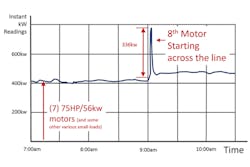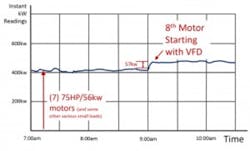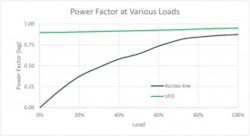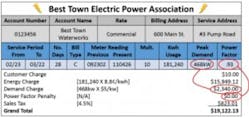Variable frequency drives (VFDs) have changed the way end users specify pump motors and the control of them. In years past, few pumps were fitted with VFDs, but now that they are becoming less expensive and offered in smaller physical sizes, they have become common at any horsepower. VFDs have evolved to be considered extremely reliable and user friendly. Users have expected energy savings by reducing the motor speed and even noticed a reduction in electricity costs when slowing down the motor. If you slow down the motor, the kilowatt usage follows almost linearly. This begs the question: Have other benefits of VFDs been observed, or have they been disregarded? This article discusses external benefits of VFDs and how they are often overlooked.
Inrush currents & demand charges
Figure 2. Demand readings with VFDs
Most household motors, when started, strain the electricity supplied by the utility. Examples include an air conditioner, heat pump unit or pool pump that use electric motors of considerable size compared to other loads in the house such as lights, televisions, computers and electric ovens. For example, when the air conditioner starts, the lights dim for a brief period. Perhaps this is not as noticeable with compact fluorescent lamps or light-emitting diodes (LEDs) as it is with incandescent bulbs. Why does a motor cause this, and the oven or heater does not? The key reason is that motors behave as inductive loads and "slip" until they reach the rated speed. In doing so, the initial loading is about six times that of its nominal load. To further define this, an air conditioner motor may consume roughly 6,000 watts (W) when running but more than 36,000 W when starting. An oven or heater has very little inrush because it is purely resistive.
Take that same concept and put it in a larger scale pumping environment. Suppose a wastewater plant has seven 75-horsepower (hp)/56-kilowatt (kW) pump motors in operation that are connected without a VFD (more commonly known as "across-the-line" starters). The total consumption would be 525 hp/392 kW. Starting just one more of these motors results in six times the load factor while the motor comes online. This inrush of current puts a strain on the system because, for a brief moment, the utility does not see simply an additional 75-hp load but a 450-hp/336-kW burden of starting current (see Figure 1). Imagine putting two or more motors across the line simultaneously. Not only will lights dim, but large voltage disturbances will also occur on the plant’s power supply fed from the utility.
Does this cause the utility concern? Yes. When sizing up power lines and transformers to feed the facility, it must account for these types of demanding loads. Is it a one-time cost? Absolutely not. The utility must be ready to supply these inrushes at any given moment. No one calls the utility’s generating station hundreds of miles away and tells it to expect this type of load. These inrush demands are monitored by the meter on the service entrance to the facility in 15-minute intervals. The largest average demand on the system over a 15-minute window will actually setup the demand rate for the entire billing cycle, although this may occur only once or a few times. These demands show up as a demand penalty on the bill. In some cases the demand penalty can contribute to 30 percent or more of the bill. (On an interesting side note, utilities have softened the wording of these charges, so now the term is referred to as "demand factor." One can suppose it would be less noticeable to refer to it as demand factor instead of demand penalty or demand charges.)
When VFDs are added, the larger demand loads are negligible because VFDs limit inrush to the motor and thus act as a buffer to the utility source. With a VFD, the demand load is closer to the actual average load (see Figure 2). This reduction is a benefit that gets overlooked often when VFDs are added.
Lightly loaded motors & power factor penalties
One way to reduce flow in a pipeline is to use valves. In doing so, the motor load lightens, and the energy consumed in kW is reduced. When the load is reduced, the power factor (PF) of the motor is reduced as well. This occurs because the motor looks more reactive than resistive. In electrical terms, the motor current will lag the motor voltage. PF in simple terms is a measurement of resistive (true) power/apparent power:
Figure 3. Power factor of VFDs and across-the-line motor
Reactive loads have a lagging PF, and utilities must supply additional reactive power. In most locations, once the PF is reduced below 0.90, the utility will start adding penalties to the consumer’s billing for not being efficient with the power consumed. PFs below 0.80 can see a large charge added to the utility bill. To counteract lagging PF, the facility must add PF correction capacitors. Capacitors behave in the opposite way and cause leading PFs. The sum of capacitance to inductance will result in the PF the utility sees (see sidebar on page 22).
Assuming a VFD is inserted in front of the motor, instead of reducing flow by using a valve, the pump motor will simply be slowed down to a lesser speed. In doing so, VFD current as seen by the utility is almost perfectly in sync with the voltage because VFDs have near unity (1.0) PF. The overall result is the PF penalty is reduced or in most cases eliminated if these VFDs are installed on all motors. Figure 3 shows the PF at various points when using an across-the-line motor or a VFD.
Utilities & billing
All residential, commercial or industrial consumers pay for kilowatt-hour usage. However, with commercial and industrial users, other charges will be added such as demand charges and PF penalty charges (if they apply). Demand charges are based strictly on the maximum average used in a 15-minute window and then applied for the full billing period. PF is similarly billed, but the lower the PF is, the larger the penalty.
Figure 4. Sample utility bill without VFDs
Consider two electric bills, one with across-the-line pump motors with flow reduction valves that start and stop throughout the day, and one with VFDs that instead of starting and stopping simply slows down and speeds up as the usage needs change.
In Figure 4, notice the demand and PF charges add up to 27 percent of the total bill when not using VFDs for flow control. In Figure 5, the charges for demand are reduced, and the PF penalty is removed because it is above 0.90.
Figure 5. Sample utility bill with VFDs
Has the industrial consumer noticed this reduction outside the normal reduction in electrical usage? If not, maybe now is the time to review the power bill to see how many penalties may be lower than before.
Both demand charges and PF charges can be reduced considerably in addition to the reduction of energy consumed when slowing these pump motors instead of valves. Knowing this, the payback time of replacing motor starters with VFDs could be calculated given enough data of usage. Their smaller physical sizes, lower costs and user friendliness have caused their use to increase considerably. However, VFDs are not a fix-all solution; they add harmonics to the grid and can cause power quality to deteriorate. This is a topic on its own that will be saved for a future article.
Jeffery Lovelace, P.E., is principal engineer for National Power Quality and Consulting LLC in Richmond, Texas. He has 20 years of experience with VFDs, automation systems and power quality analysis. Lovelace has a bachelor’s degree in electrical engineering from Mississippi State University and is a registered Professional Engineer recognized and licensed by the state of Arkansas. He is a senior member of Institute of Electrical and Electronics Engineers and an active member of the National Society of Professional Engineers. Lovelace may be reached at [email protected].






